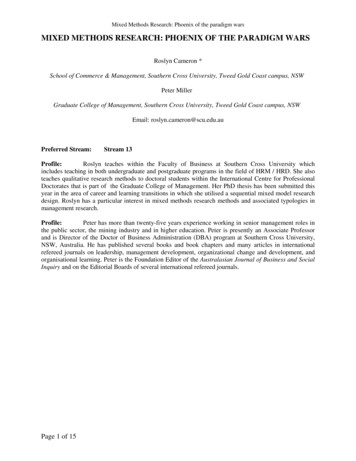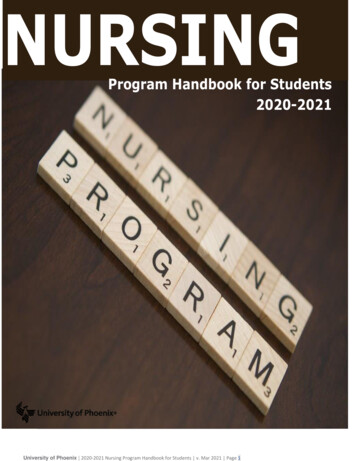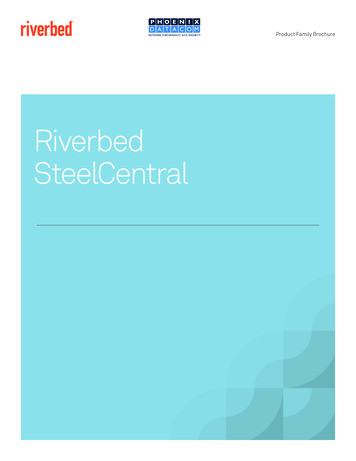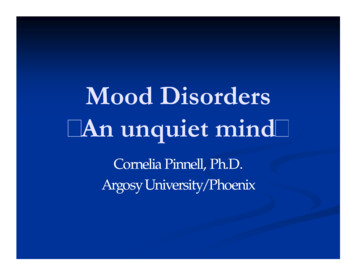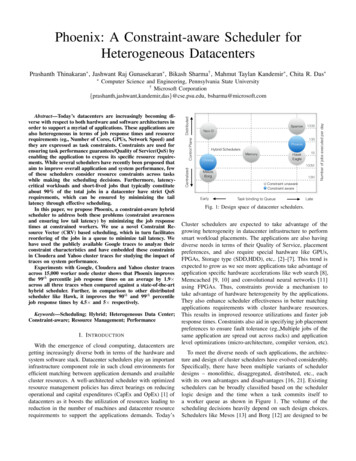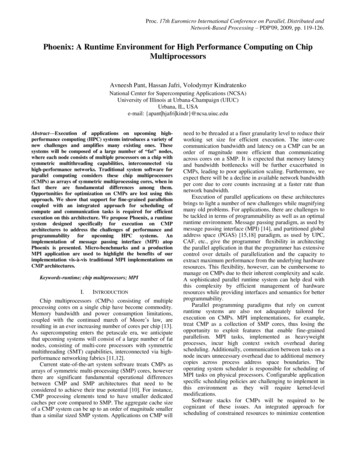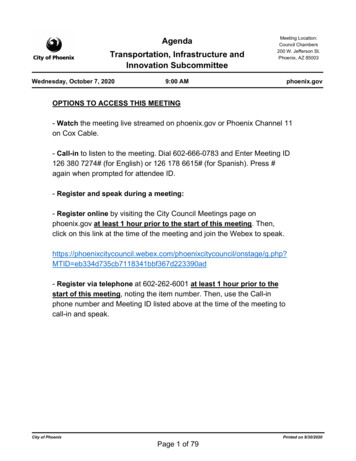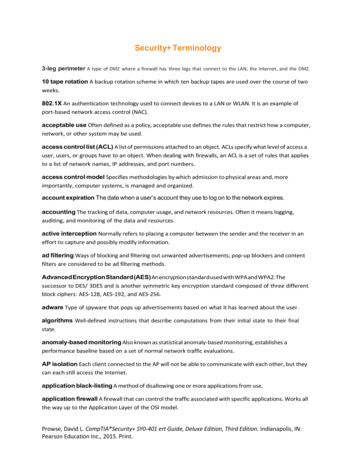
Transcription
Security Terminology3-leg perimeter A type of DMZ where a firewall has three legs that connect to the LAN, the Internet, and the DMZ.10 tape rotation A backup rotation scheme in which ten backup tapes are used over the course of twoweeks.802.1X An authentication technology used to connect devices to a LAN or WLAN. It is an example ofport‐based network access control (NAC).acceptable use Often defined as a policy, acceptable use defines the rules that restrict how a computer,network, or other system may be used.access control list (ACL) A list of permissions attached to an object. ACLs specify what level of access auser, users, or groups have to an object. When dealing with firewalls, an ACL is a set of rules that appliesto a list of network names, IP addresses, and port numbers.access control model Specifies methodologies by which admission to physical areas and, moreimportantly, computer systems, is managed and organized.account expiration The date when a user’s account they use to log on to the network expires.accounting The tracking of data, computer usage, and network resources. Often it means logging,auditing, and monitoring of the data and resources.active interception Normally refers to placing a computer between the sender and the receiver in aneffort to capture and possibly modify information.ad filtering Ways of blocking and filtering out unwanted advertisements; pop‐up blockers and contentfilters are considered to be ad filtering methods.Advanced Encryption Standard (AES) An encryption standard used with WPA and WPA2. Thesuccessor to DES/ 3DES and is another symmetric key encryption standard composed of three differentblock ciphers: AES‐128, AES‐192, and AES‐256.adware Type of spyware that pops up advertisements based on what it has learned about the user.algorithms Well‐defined instructions that describe computations from their initial state to their finalstate.anomaly-based monitoring Also known as statistical anomaly‐based monitoring, establishes aperformance baseline based on a set of normal network traffic evaluations.AP isolation Each client connected to the AP will not be able to communicate with each other, but theycan each still access the Internet.application black-listing A method of disallowing one or more applications from use.application firewall A firewall that can control the traffic associated with specific applications. Works allthe way up to the Application Layer of the OSI model.Prowse, David L. CompTIA Security SY0‐401 ert Guide, Deluxe Edition, Third Edition. Indianapolis, IN:Pearson Education Inc., 2015. Print.
application-level gateway (ALG) Applies security mechanisms to specific applications, such as FTP and/or BitTorrent. It supports address and port translation and checks whether the type of application trafficis allowed.application white-listing A method of restricting users to specific applications.ARP poisoning An attack that exploits Ethernet networks, and it may enable an attacker to sniff framesof information, modify that information, or stop it from getting to its intended destination.asymmetric key algorithm A type of cipher that uses a pair of different keys to encrypt and decryptdata.attack vector The path or means by which an attacker gains access to a computer.audit trails Records or logs that show the tracked actions of users, regardless of whether the userssuccessfully completed the actions.authentication When a person’s identity is confirmed. Authentication is the verification of a person’sidentity.authorization When a user is granted access to specific resources after authentication is complete.availability Data is obtainable regardless of how information is stored, accessed, or protected.backdoors Used in computer programs to bypass normal authentication and other securitymechanisms in place.back-to-back perimeter A type of DMZ where the DMZ is located between the LAN and application‐level gateway (ALG) Applies security mechanisms to specific applications, such as FTP and/ or BitTorrent.It supports address and port translation and checks whether the type of application traffic is allowed.blackout When a total loss of power for a prolonged period occurs.blanket purchase agreement (BPA) A service‐level agreement (SLA) that is reoccurring.block cipher A type of algorithm that encrypts a number of bits as individual units known as blocks.bluejacking The sending of unsolicited messages to Bluetooth‐enabled devices such as mobile phonesand tablets.bluesnarfing The unauthorized access of information from a wireless device through a Bluetoothconnection.botnet A group of compromised computers used to distribute malware across the Internet; themembers are usually zombies.broadcast storm When there is an accumulation of broadcast and multicast packet traffic on the LANcoming from one or more network interfaces.brownout When the voltage drops to such an extent that it typically causes the lights to dim and causescomputers to shut off.Prowse, David L. CompTIA Security SY0‐401 ert Guide, Deluxe Edition, Third Edition. Indianapolis, IN:Pearson Education Inc., 2015. Print.
brute-force attack A password attack where every possible password is attempted.buffer overflow When a process stores data outside the memory that the developer intended to beused for storage. This could cause erratic behavior in the application, especially if the memory alreadyhad other data in it.business impact analysis The examination of critical versus noncritical functions, it is part of a businesscontinuity plan (BCP).butt set (or lineman’s handset) A device that looks similar to a phone but has alligator clips that canconnect to the various terminals used by phone equipment, enabling a person to listen in to aconversation.CAM table The Content Addressable Memory table, a table that is in a switch’s memory that containsports and their corresponding MAC addresses.CAPTCHA A type of challenge‐response mechanism used primarily in websites to tell whether or not theuser is human. Stands for Completely Automated Public Turing test to tell Computers and HumansApart.certificate authority (CA) The entity (usually a server) that issues digital certificates to users.certificate revocation list (CRL) A list of certificates no longer valid or that have been revoked by theissuer.certificates Digitally signed electronic documents that bind a public key with a user identity.chain of custody Documents who had custody of evidence all the way up to litigation or a court trial (ifnecessary) and verifies that the evidence has not been modified.Challenge Handshake Authentication Protocol (CHAP) An authentication scheme used by the Point‐to‐Point Protocol (PPP) that is the standard for dial‐up connections.change management A structured way of changing the state of a computer system, network, or ITprocedure.chromatic dispersion The refraction of light as in a rainbow. If light is refracted in such a manner onfiber‐optic cables, the signal cannot be read by the receiver.cipher An algorithm that can perform encryption or decryption.circuit-level gateway Works at the Session Layer of the OSI model and applies security mechanismswhen a TCP or UDP connection is established; acts as a go‐between for the Transport and ApplicationLayers in TCP/ IP.closed-circuit television (CCTV) A video system (often used for surveillance) that makes use oftraditional coaxial‐based video components, but is used privately, within a building or campus.cloud computing A way of offering on‐demand services that extend the capabilities of a person’scomputer or an organization’s network.Prowse, David L. CompTIA Security SY0‐401 ert Guide, Deluxe Edition, Third Edition. Indianapolis, IN:Pearson Education Inc., 2015. Print.
cluster Two or more servers that work with each other.cold site A site that has tables, chairs, bathrooms, and possibly some technical setup (for example, basicphone, data, and electric lines), but will require days if not weeks to set up properly.Common Vulnerabilities and Exposures (CVE) An online list of known vulnerabilities (and patches)to software, especially web servers. It is maintained by the MITRE Corporation.computer security audits Technical assessments made of applications, systems, or networks.confidentiality Preventing the disclosure of information to unauthorized persons.content filters Individual computer programs that block external files that use Java‐Script or imagesfrom loading into the browser.cookies Text files placed on the client computer that store information about it, which could includeyour computer’s browsing habits and credentials. Tracking cookies are used by spyware to collectinformation about a web user’s activities. Session cookies are used by attackers in an attempt to hijack asession.cross-site request forgery (XSRF) An attack that exploits the trust a website has in a user’s browser inan attempt to transmit unauthorized commands to the website.cross-site scripting (XSS) A type of vulnerability found in web applications used with session hijacking.crosstalk When a signal transmitted on one copper wire creates an undesired effect on another wire;the signal “bleeds” over, so to speak.cryptanalysis attack A password attack that uses a considerable set of precalculated encryptedpasswords located in a lookup table.cryptographic hash functions Hash functions based on block ciphers.cryptography The practice and study of hiding information.data emanation (or signal emanation) The electromagnetic field generated by a network cable ornetwork device, which can be manipulated to eavesdrop on conversations or to steal data.Data Encryption Standard (DES) An older type of block cipher selected by the United States federalgovernment back in the 1970s as its encryption standard; due to its weak key, it is now considereddeprecated.data loss prevention (DLP) Systems that are designed to protect data by way of content inspection.They are meant to stop the leakage of confidential data, often concentrating on communications.default account An account installed by default on a device or within an operating system with a defaultset of user credentials that are usually insecure.defense in depth The building up and layering of security measures that protect data from inception,on through storage and network transfer, and lastly to final disposal.Prowse, David L. CompTIA Security SY0‐401 ert Guide, Deluxe Edition, Third Edition. Indianapolis, IN:Pearson Education Inc., 2015. Print.
demilitarized zone (DMZ) A special area of the network (sometimes referred to as a subnetwork) thathouses servers that host information accessed by clients or other networks on the Internet.denial-of-service (DoS) A broad term given to many different types of network attacks that attempt tomake computer resources unavailable.dictionary attack A password attack that uses a prearranged list of likely words, trying each of themone at a time.differential backup Type of backup that backs up only the contents of a folder that have changed sincethe last full backup.Diffie-Hellman key exchange Invented in the 1970s, it was the first practical method for establishing ashared secret key over an unprotected communications channel.digital signature A signature that authenticates a document through math, letting the recipient knowthat the document was created and sent by the actual sender and not someone else.directory traversal Also known as the ./ (dot dot slash) attack, a method of accessing unauthorizedparent directories.disaster recovery plan A plan that details the policies and procedures concerning the recovery and/ orcontinuation of an organization’s technology infrastructure.discretionary access control (DAC) An access control policy generally determined by the owner.disk duplexing When each disk is connected to a separate controller.distributed denial-of-service (DDoS) An attack in which a group of compromised systems attack asingle target, causing a DoS to occur at that host, usually using a botnet.diversion theft When a thief attempts to take responsibility for a shipment by diverting the delivery to anearby location.DNS poisoning The modification of name resolution information that should be in a DNS server’s cache.domain name kiting The process of deleting a domain name during the five‐day grace period (knownas the add grace period, or AGP) and immediately reregistering it for another five‐day period to keep adomain name indefinitely and for free.due care The mitigation action that an organization takes to defend against the risks that have beenuncovered during due diligence.due diligence Ensuring that IT infrastructure risks are known and managed.due process The principle that an organization must respect and safeguard personnel’s rights.dumpster diving When a person literally scavenges for private information in garbage and recyclingcontainers.Easter egg A platonic extra added to an OS or application as a sort of joke; the harmless cousin of thelogic bomb.Prowse, David L. CompTIA Security SY0‐401 ert Guide, Deluxe Edition, Third Edition. Indianapolis, IN:Pearson Education Inc., 2015. Print.
eavesdropping When a person uses direct observation to “listen” in to a conversation.electromagnetic interference (EMI) A disturbance that can affect electrical circuits, devices, and cablesdue to electromagnetic conduction or radiation.elliptic curve cryptography (ECC) A type of public key cryptography based on the structure of anelliptic curve.encryption The process of changing information using an algorithm (or cipher) into another form that isunreadable by others— unless they possess the key to that data.ethical hacker An expert at breaking into systems and can attack systems on behalf of the system’sowner and with the owner’s consent.evil twin A rogue wireless access point that uses the same SSID as a nearby legitimate access point.explicit allow When an administrator sets a rule that allows a specific type of traffic through a firewall,
application-level gateway (ALG) Applies security mechanisms to specific applications, such as FTP and/ or BitTorrent. It supports address and port translation and checks whether the type of application traffic is allowed. application white-listing A method of restricting users to specific applications.




